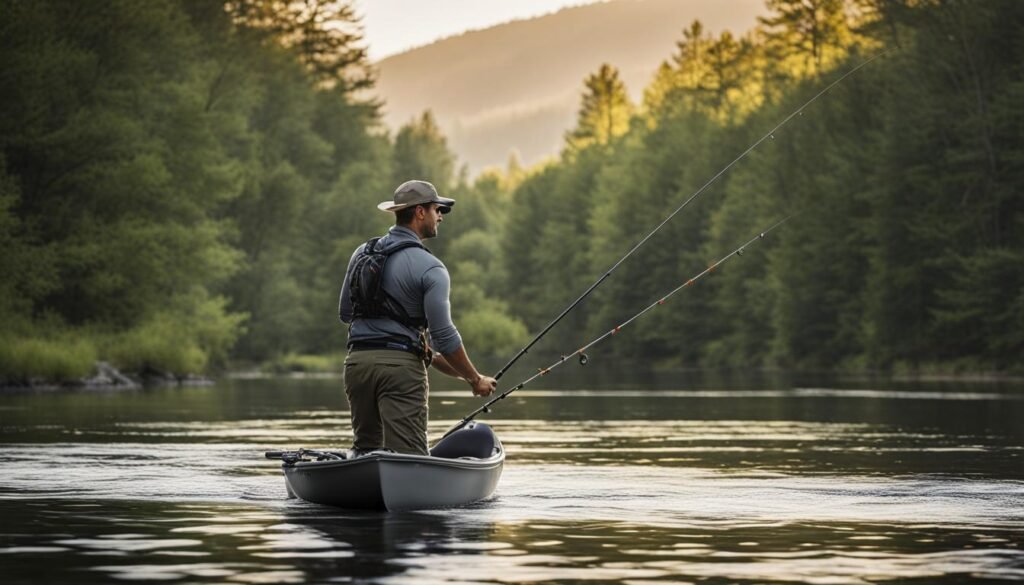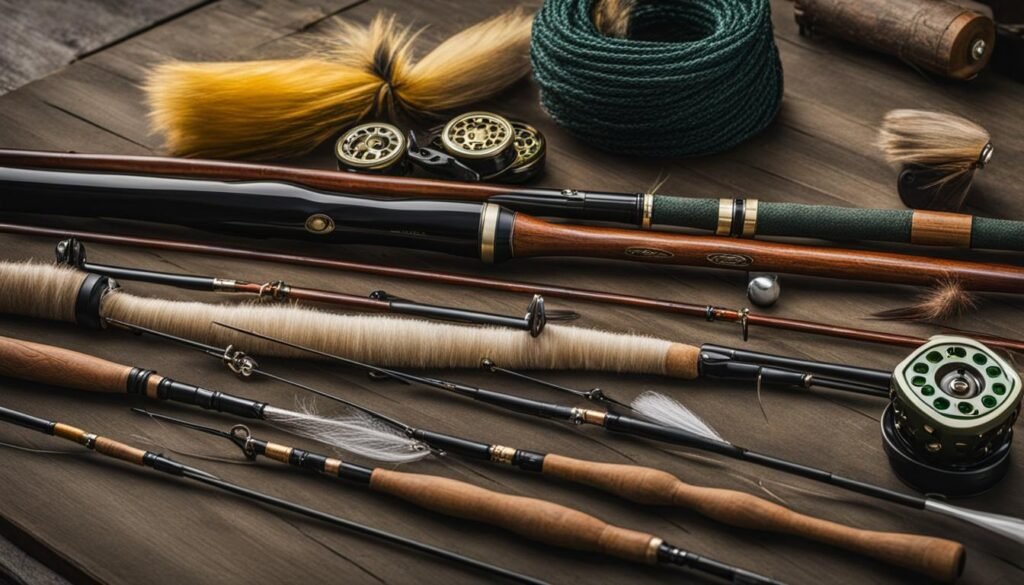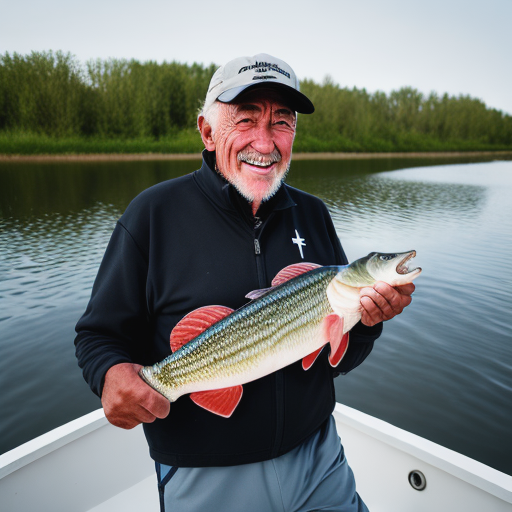Fiberglass and graphite fly rods are two popular choices among anglers. Both materials have their own strengths and limitations. Let’s compare the two to determine which is the best option for your fly fishing needs.
Key Takeaways:
- Fiberglass and graphite fly rods are commonly used in fly fishing.
- Fiberglass rods offer great feel and control, making them suitable for delicate presentations.
- Graphite rods are powerful and efficient, ideal for cutting through the wind and casting heavy flies.
- Consider your fishing preferences and needs when choosing between fiberglass and graphite fly rods.
- Bamboo fly rods have a unique feel and excel in subtle presentations.
Strengths of Fiberglass Fly Rods
Fiberglass fly rods offer several advantages that make them a popular choice among anglers. One of the key benefits of fiberglass rods is their exceptional feel. When casting, anglers can easily feel the rod load, allowing for more control and accuracy. This sensitivity is especially advantageous when fishing in situations that require delicate presentations, such as targeting trout in small streams.
Another advantage of fiberglass fly rods is their slower casting tempo. The slower action of fiberglass rods makes them easier to control, particularly for beginner or less experienced anglers. This characteristic allows for smoother, more controlled casts, resulting in improved accuracy and presentation.
In addition to their feel and control, fiberglass rods are known for their durability. These rods are less likely to be damaged by physical impact, making them a reliable choice for anglers fishing in rugged terrain or areas with potential casting obstacles. Moreover, fiberglass fly rods are more affordable compared to other materials, making them an accessible option for anglers on a budget.
The Benefits of Fiberglass Fly Rods:
- Exceptional feel for easy rod loading
- Slower casting tempo for improved control
- Excellent for delicate presentations
- Resistant to physical impact
- Affordable option for anglers
Limitations of Fiberglass Fly Rods
Fiberglass fly rods have many strengths, but they also come with certain limitations that anglers should be aware of. Understanding these limitations will help you make an informed decision when choosing the right fly rod for your needs.
1. Performance in Windy Conditions
One of the main limitations of fiberglass fly rods is their performance in windy conditions. Due to their slower line speed compared to graphite rods, fiberglass rods can struggle to cut through the wind, resulting in reduced accuracy and casting distance. If you frequently fish in windy areas or during windy seasons, you may need to consider other options.
2. Casting Fatigue
Another limitation of fiberglass fly rods is their weight, especially in higher line weights and longer lengths. Fiberglass rods tend to be heavier compared to graphite rods, which can lead to casting fatigue during extended fishing sessions. If you plan on casting for long periods or targeting larger fish that require heavier rods, you may find fiberglass rods to be less comfortable and more tiring to use.
3. Limited Performance with Large Flies
While fiberglass rods excel in delicate presentations, they may not perform as well with large, wind-resistant flies. The slower action of fiberglass rods can make it challenging to generate the necessary power and line speed to effectively cast heavier flies. If you often fish with larger streamers or heavily weighted flies, you may want to consider a different rod material that can provide better performance in such scenarios.
| Limitations of Fiberglass Fly Rods |
|---|
| Performance in Windy Conditions |
| Casting Fatigue |
| Limited Performance with Large Flies |
While fiberglass fly rods have their limitations, it’s important to remember that these limitations may not be deal-breakers for every angler. If your fishing style primarily involves delicate presentations, fishing in calm conditions, and using smaller flies, fiberglass rods can still be a great choice. It’s all about finding the right balance between your specific fishing needs and the strengths and limitations of different rod materials.
Strengths of Graphite Fly Rods
Graphite fly rods offer anglers a range of advantages, making them a popular choice among fly fishers. These rods are known for their power, efficiency, and versatility, making them the top choice for many anglers. Here are some key strengths of graphite fly rods:
- High Line Speed: Graphite rods have the ability to generate high line speeds, allowing for longer and more accurate casts. This makes them particularly effective in cutting through the wind and casting heavy flies.
- Fast Recovery Rate: Graphite rods have a fast recovery rate, which means they quickly regain their original shape after being flexed during a cast. This allows for tighter loops and increased distance and accuracy.
- Stiffness and Fighting Power: Graphite fly rods are known for their stiffness, giving anglers increased control and authority when fighting tough fish. They provide the strength needed to handle larger fish and challenging fishing conditions.
- Lightweight: Graphite rods are extremely lightweight, making them comfortable to cast for extended periods. This makes them ideal for anglers using higher line weights or longer rods.
In summary, graphite fly rods offer power, efficiency, and versatility. They excel in generating high line speeds, have a fast recovery rate, and provide the stiffness needed for fighting tough fish. Their lightweight construction adds to their appeal, making them suitable for various fishing conditions.

Table: Comparison of Fiberglass and Graphite Fly Rods
| Strengths | Fiberglass Fly Rods | Graphite Fly Rods |
|---|---|---|
| Feel and Control | Great feel, easy to control | – |
| Casting Tempo | Slower tempo, easier to control | – |
| Delicate Presentations | Excellent for delicate presentations | – |
| Physical Impact | Less likely to be damaged | – |
| Power and Efficiency | – | High line speeds, fast recovery rate |
| Fighting Power | – | Stiffness provides authority when fighting tough fish |
| Weight | Lightweight | Extremely lightweight |
| Affordability | Affordable | – |
Limitations of Graphite Fly Rods
While graphite fly rods offer numerous advantages, it’s essential to consider their limitations before making a purchasing decision. Understanding these limitations will help you determine if graphite fly rods are the right choice for your specific fishing needs.
1. Potential Lack of Control and Precision
Graphite rods are known for their fast action, which can result in less control and a narrower loop shape compared to slower action rods like fiberglass. This can make it more challenging to achieve delicate and precise presentations, particularly in situations that require subtle fly placement.
2. Susceptibility to Breakage
While graphite rods are known for their exceptional strength and power, they can be more susceptible to breakage if not handled properly. It’s important to be mindful of how you handle and transport your graphite fly rod to avoid any accidental damage that may compromise its performance.
Quote: “Graphite rods may lack the finesse and control of slower action rods, but their power and versatility make them a top choice for many anglers.” – Expert Angler
3. Higher Cost
High-performance graphite fly rods can be more expensive compared to other materials like fiberglass. The advanced technology and materials used in manufacturing graphite rods contribute to their higher price point. However, it’s worth noting that there are graphite rod options available at various price ranges, so you can still find a suitable option within your budget.
Despite these limitations, graphite fly rods continue to be a popular choice among anglers due to their power, versatility, and overall performance. Understanding the limitations can help you make an informed decision and determine if graphite rods align with your fishing style and preferences.
Choosing Between Fiberglass and Graphite Fly Rods
When it comes to selecting the right fly rod for your fishing adventures, the choice often boils down to fiberglass or graphite. Both materials have their own unique characteristics that cater to different fishing styles and preferences. To help you make an informed decision, let’s compare the two and see which one suits your needs best.
Strengths of Fiberglass Fly Rods
If you value a rod with great feel and control, then fiberglass is a fantastic option. Fiberglass fly rods excel in providing anglers with a sensitive and intuitive experience, allowing you to detect even the subtlest of strikes. Their slower casting tempo makes them easy to control, making them an excellent choice for precision and delicate presentations. Additionally, fiberglass rods are known for their affordability, making them a popular choice among budget-conscious anglers.

Strengths of Graphite Fly Rods
On the other hand, if power, efficiency, and versatility are what you seek, graphite fly rods are the way to go. These rods are designed for high-performance fishing, offering faster line speeds and greater accuracy. Graphite rods have a fast recovery rate, allowing for tighter loops and longer casts. They are particularly effective in cutting through the wind and handling heavier flies. Furthermore, their lightweight nature makes them well-suited for longer rods and higher line weights, providing you with the authority needed to tackle tough fish.
Choosing the Right Fly Rod
Ultimately, the choice between fiberglass and graphite fly rods depends on your personal fishing style and the specific conditions you’ll be facing. If you prioritize feel, delicate presentations, and affordability, fiberglass is the way to go. On the other hand, if you value power, efficiency, and versatility, graphite is your best bet. Take into consideration the type of fishing you’ll be doing and the strengths of each material before making a decision. Remember, there is no one-size-fits-all answer – the best fly rod is the one that suits your unique fishing needs.
When to Choose Bamboo Fly Rods
Bamboo fly rods offer a unique and distinctive experience for fly anglers. Their slower and more flexible action makes them ideal for subtle and delicate presentations, particularly when fishing with dry flies, emergers, and unweighted small nymphs. The natural flexibility of bamboo rods helps protect light tippets from breaking, providing a more forgiving experience for anglers who prioritize finesse and precision in their fishing.
However, it’s important to note that bamboo fly rods have their limitations. Compared to modern graphite and fiberglass rods, bamboo rods tend to be heavier and less versatile. They may not have the same power and efficiency as graphite rods, which excel in cutting through the wind and casting heavy flies. Additionally, bamboo rods require more maintenance and care to ensure their longevity.
Overall, the decision to choose bamboo fly rods depends on your fishing style and preferences. If you value the traditional and nostalgic feel of bamboo, and prioritize delicate presentations and finesse over raw power, then bamboo rods may be the right choice for you. However, if you’re looking for a more versatile and high-performance option, graphite or fiberglass rods may be better suited to your needs.
| Material | Strengths | Limitations |
|---|---|---|
| Fiberglass | – Great feel | – Struggles in windy conditions |
| Graphite | – Power and efficiency | – Less delicate and precise |
| Bamboo | – Unique feel and subtlety | – Heavier and less versatile |
Where to Start with Bamboo Fly Rods
If you’re intrigued by the unique feel and delicate presentations that bamboo fly rods offer, it’s worth considering adding one to your fly fishing arsenal. While bamboo rods require a different casting technique than their fiberglass or graphite counterparts, they can provide a rewarding and nostalgic experience on the water.
If you’re new to fly fishing or have limited experience with bamboo rods, it’s recommended to start with a more forgiving and user-friendly option, such as a graphite rod. This will help you develop your casting skills and gain confidence before transitioning to the slower action and nuances of bamboo. Once you’ve honed your casting technique and feel ready to explore the world of bamboo fly rods, there are several reputable options to consider.
Winston Bamboo Fly Rod
For anglers seeking a premium bamboo fly rod, the Winston Bamboo Fly Rod is a top choice. Known for their craftsmanship and attention to detail, Winston rods are meticulously handcrafted using the finest quality Tonkin bamboo. With a slow, smooth action, these rods offer exceptional feel and control for delicate presentations. Whether you’re targeting trout on small streams or pursuing finicky fish in technical waters, the Winston Bamboo Fly Rod delivers both performance and beauty.
Epic Reference Series
Another notable option in the world of bamboo fly rods is the Epic Reference Series. These rods are renowned for their modern design and exceptional performance. Crafted using advanced technology and high-quality materials, the Epic Reference Series offers a balance of classic aesthetics and contemporary performance. Whether you’re casting dry flies or nymphing with small, unweighted patterns, these rods provide the finesse and precision needed for a successful day on the water.
When selecting a bamboo fly rod, consider factors such as length, weight, and action to ensure the rod matches your fishing style and target species. It’s also worth exploring different brands and models to find the rod that feels right in your hands. Each bamboo rod has its own unique characteristics and personality, and finding the perfect match can be a rewarding journey.
As with any fly rod purchase, it’s recommended to try out different rods and seek advice from experienced anglers or fly shops. Ultimately, the best bamboo fly rod is the one that resonates with your personal preferences and enhances your enjoyment of the sport.
Conclusion
After comparing fiberglass, graphite, and bamboo fly rods, it’s clear that each material has its own advantages and limitations. Fiberglass rods are a great option for anglers seeking affordability and delicate presentations. They offer a great feel and are less likely to be damaged by physical impact. On the other hand, graphite rods provide power, efficiency, and versatility. They excel in windy conditions, generating high line speeds and casting heavy flies. Bamboo rods, with their unique feel and slower action, are ideal for subtle and delicate presentations.
When choosing the best fly rod material for your needs, it’s important to consider your fishing style, preferences, and the specific conditions you’ll be fishing in. If you prioritize feel, affordability, and delicate presentations, fiberglass rods may be the right choice for you. If power, efficiency, and versatility are important, graphite rods are worth considering. And if you enjoy subtle presentations and a distinct feel, bamboo rods may be the perfect fit.
Ultimately, the best way to find the right fly rod material is to try out different rods and see which one suits you best. Keep in mind that each material has its own strengths and limitations, so it’s important to assess your fishing needs and make a decision based on that. Whether you’re a seasoned angler or just starting out, choosing the right fly rod material will greatly enhance your fly fishing experience.
FAQ
What are the strengths of fiberglass fly rods?
Fiberglass fly rods offer great feel, are easier to control, and are excellent for delicate presentations. They are also more affordable compared to other materials.
What are the limitations of fiberglass fly rods?
Fiberglass fly rods struggle in windy conditions, have slower line speed, and can be heavier, causing casting fatigue. They may not perform as well with large, wind-resistant flies.
What are the strengths of graphite fly rods?
Graphite fly rods are known for their power, efficiency, and high line speeds. They have a fast recovery rate, provide tight loops, and are extremely lightweight.
What are the limitations of graphite fly rods?
Graphite fly rods may not be as delicate and precise as fiberglass rods. They can be more delicate and prone to breakage if not handled properly. High-performance graphite rods can also be expensive.
How do I choose between fiberglass and graphite fly rods?
The choice depends on your fishing preferences and needs. If you prioritize feel, delicate presentations, and affordability, fiberglass may be the better option. If power, efficiency, and versatility are important to you, graphite may be the best choice. Consider the type of fishing and specific conditions before making a decision.
When should I choose bamboo fly rods?
Bamboo fly rods are ideal for subtle and delicate presentations, especially when fishing with dry flies, emergers, and unweighted small nymphs. They excel in protecting light tippets from breaking.
Where should I start with bamboo fly rods?
If you’re new to fly fishing, it’s recommended to start with a graphite rod to familiarize yourself with casting techniques. Some recommended bamboo fly rods include the Winston Bamboo Fly Rod and Epic Reference Series.

